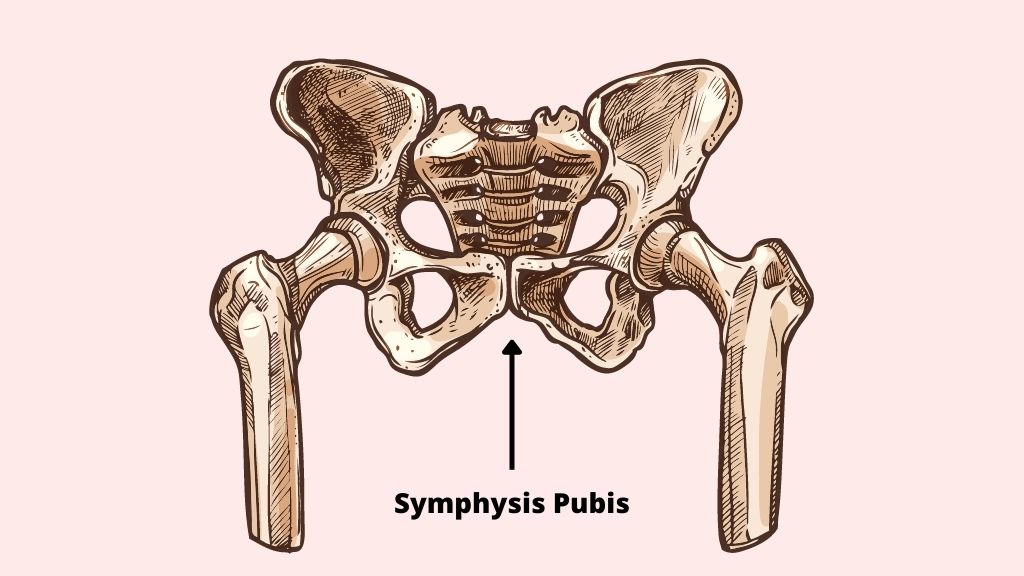
Table of Contents
Symphysis pubis dysfunction, abbreviated as SPD, is a group of health symptoms that leads to discomfort or pain in the pelvic region. In most cases, this pain is experienced during pregnancy, when the pelvic joints on both your back and front move unevenly and become stiff.
Pubis symphysis dysfunction is also sometimes referred to as pelvic girdle pain and the condition is not harmful to your body but could be extremely painful. The severe pain may at times affect your mobility.
Let’s check out what symptoms you should look out for if you suspect you have pubic symphysis
Symptoms of Symphysis Pubis Dysfunction
The symptoms of pelvic girdle pain or SPD may differ for various people both in terms of presentation and severity. The most common symptoms of SPD are:
- Pain in your perineum (the area between your vagina and anus)
- Pain in the lower back on either or both sides
- Pain in the front of your pubic bone
The pain caused by pubis symphysis dysfunction at times affects your thighs and you might also feel or hear a clicking or grinding sound from your pelvis. The pain becomes even more obvious when you are engaged in the following activities:
- Turning over in your bed
- Putting your weight on one of your legs
- Using the stairs
- Walking
It might also seem challenging to widen your legs which means difficulty in doing daily tasks such as
- Getting in a car
- Getting out of a car
- Getting dressed
- Getting out of bed
Causes of Symphysis Pubis Dysfunction
Pregnancy is the foremost cause of pubis symphysis dysfunction and it affects 1 in 5 pregnant women. Pregnancy hormones such as relaxin loosen the muscles and ligaments in a pregnant woman’s body and affect these areas in particular:
- Pelvis
- Pelvic floor
- Stomach
- Hips
This loosening of muscles and ligaments is intended to increase the motion of your body to enable easy childbirth. However, it also means your joints are loose enough to make you lose your balance because of their increased mobility. This leads to pain or discomfort in the body that can turn unbearable at times.
Sometimes these pregnancy hormones are released in early pregnancy so you might experience symptoms of SPD long before childbirth. The baby’s position and weight are also suspected culprits of pubis symphysis dysfunction.
It is unlikely for SPD to occur outside pregnancy but there are still chances if you have suffered pelvic injuries from conditions like osteoarthritis. At times, certain cases of SPD have no known causes.
How is Symphysis Pubis Dysfunction Diagnosed?
Diagnosing pubis symphysis dysfunction at its early stages can be helpful while treating it. Once you are pregnant and experiencing SPD, get in touch with your healthcare provider or doctor to sort the diagnosis out. They will refer you to a physiotherapist who can assess the strength and stability of your pelvic muscles and joints. They will also suggest some symphysis pubis dysfunction exercises to relieve the pain.
Can Symphysis Pubis Dysfunction Lead to a Complicated Pregnancy?
SPD will not medically harm your baby and most women with the condition have been able to give vaginal birth. However, the pain could turn chronic and it may depress you which might indirectly affect your baby. Symptoms of pubis symphysis dysfunction do not disappear entirely before childbirth so you need to do things to relieve the pain.
The U.K. group of Pelvic, Obstetric, and Gynaecological Physiotherapy suggests that you avoid these activities as much as possible if you suspect you have SPD:
- Carrying things in one hand
- Pushing heavy objects
- Vacuuming
- Lifting heavy loads, such as a toddler, shopping bags, wet laundry
- Sitting or standing for a long time
- Sitting on the floor
- Crossing your legs
- Carrying a child on your hip
- Bending and/or twisting while lifting
- Putting your weight on only one leg
Symphysis Pubis Dysfunction: Treatment Options
Physiotherapy is the first treatment option for pubis symphysis dysfunction. It aims to:
- Improve your pelvic joint position and stability
- Improve your muscle function
- Minimize your pain
A physiotherapist provides manual therapy to make sure your pelvic joints, hips, and spine move evenly. They will also suggest certain exercises that strengthen the muscles of your hips, stomach, back, and pelvic floor. Physiotherapists also suggest hydrotherapy (exercising in the water). Being in the water can take off the stress from your joints. You may also follow suggestions on positions for birth, labor, and sex.
You may be prescribed TENS therapy or pain medications in severe cases of pubis symphysis dysfunction and provided with supportive equipment such as pelvic support belts or crutches. You can apply cold or heat to the area to reduce swelling or pain.
How to Prevent Symphysis Pubis Dysfunction?
You can do very little to prevent pubic symphysis dysfunction during pregnancy. You are more prone to SPD if you have had any previous pelvic injury. Remember to take measures to protect your pelvic region from injuries.
SPD doesn’t affect your child directly but it may make your pregnancy journey a bit more difficult as it reduces your overall mobility. Some pregnant women are also medically exempted from having a vaginal delivery due to SPD. The symptoms of postpartum symphysis pubis dysfunction will be less but if they don’t seem to improve, get in touch with a doctor. They will be able to rule out any hidden health conditions.
The Bottom Line: Symphysis Pubis Dysfunction
Pubis symphysis dysfunction or pelvic girdle pain is a health condition that affects most pregnant women. It is the separation of the pelvic joints in preparation for childbirth. However, loosened joints or muscles will increase mobility which will make the person unbalanced. The uneven joints will cause immense pain and discomfort in the area.
The unbearable pain may be prevented by exercises for symphysis pubis dysfunction along with the following relief methods:
- Taking prescribed pain medications
- Hydrotherapy
- Physiotherapy
- TENS therapy
- Avoiding certain activities that involve the pelvic area
Even though severe pain due to pubis symphysis dysfunction is unavoidable during pregnancy, its pain can be eased by relief methods and exercises. In rare cases, SPD may also affect non-pregnant folks which is obvious in case they have had previous hip or pelvic injury. You must get in touch with a doctor in case of severe pain so that you can rule out any severe health conditions behind the pain.
Symphysis Pubis Dysfunction FAQs
1. What are some relief exercises for symphysis pubis dysfunction?
2. How do you get rid of pubis symphysis dysfunction?
3. What should you not do with a pubis symphysis?
4. How should you sleep with symphysis pubis dysfunction?
5. How long does it take for pubis symphysis dysfunction to heal?
6. When does pubis symphysis dysfunction usually start in pregnancy?

Dr.Mitali Rathod
Hi! I'm Dr. Mitali Rathod, and I have a deep passion for all things related to menstruation, hormones, pregnancy, and reproductive health. I enjoy simplifying these complex topics on social media to empower women with a better understanding of their bodies. My mission is to assist women in comprehending the intricacies of periods and reproductive health through a holistic and sustainable approach.
Over the past eight years and counting, I've been dedicated to helping women achieve their best possible health. This journey has included the safe delivery of over 3000 babies, both through vaginal and C-section procedures.
I take pride in my contributions to some of Ahmedabad's and Gandhinagar's best government hospitals, such as V.S. General Hospital, S.C.L. General Hospital, and Civil Hospital of Gandhinagar. My commitment to women's health and well-being continues to grow, and I look forward to making a positive impact on even more lives in the future.





